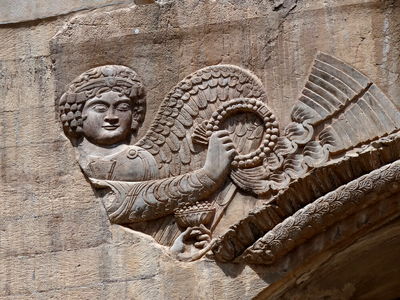“We aim to pave the way for the inscription of Taq-e Bostan on the UNESCO World Heritage list within the next 18 months,” Jabbar Gohari said.
Taq-e Bostan consists of a series of properties from prehistoric to historical periods such as Morad-Hassel Tepe, an ancient village, a Parthian graveyard, and Sassanid hunting ground. However, the most significant property of the complex belongs to the Sassanid one which comprises two porticos (large and small Ivans) as well as outstanding bas-reliefs from the same period.
“During the past years, illegal constructions and exploitations have been carried out near Taq-e Bostan. In this regard, we expect the regulatory bodies, including the Kermanshah judiciary, to solve this problem as soon as possible.”
Moreover, we have consulted with the visiting UNESCO evaluators and experts in order to come up with a clear solution, the official added.
According to Lonely Planet, the site’s extraordinary Sassanian bas-reliefs of ancient victorious kings, which are inscribed into the base of a towering cliff, divide opinions. Some travelers feel disappointed by the Taq-e Bustan experience, as there's a relatively high admission price for a few stone carvings and a duck pond, both of which are viewed easily from outside the fence. For Iranians, a visit is a joyous celebration of their incredible Persian heritage. Whether you immerse yourself or crank up the zoom lens is up to you.
Taq-e Bustan was originally the site of a Parthian royal hunting garden, but the Sassanians later added their own regal stamp. Its biggest alcove features elephant-mounted hunting scenes on the sidewalls and highlights the coronation of Khosrow II (r 590–628), beneath which the king rides off in full armor and chain mail (half a millennium before the European Black Prince made it fashionable).
The second niche shows kings Shapur III and his Roman-stomping grandfather Shapur II. To the right of the niches is a fine tableau again showing Shapur II (r 379–383), in which he is depicted trampling over the Roman emperor Julian the Apostate (whom he defeated in 363) and receiving a crown of blessings from the Zoroastrian god Mithras.
It is said that late afternoon is the best time to visit, as the cliff turns a brilliant orange in the setting sun, which then dies poetically on the far side of the duck pond. The surrounding open-air restaurants rock out till late in the evening, and the carvings are warmly floodlit. The site is 10km north of Kermanshah's city center.
Kermanshah, formerly Bakhtaran, the capital of Kermanshah province, was founded in the 4th century CE by Bahram IV of the Sasanian dynasty.
Conquered by the Arabs in 640, the town was called Qirmasin (Qirmashin). Under the Seljuk rule in the 11th century, it was the chief town of Kordestan. The Safavids (ruled 1501–1736) fortified the town, and the Qajars repulsed an attack by the Turks during Fath Ali Shah’s rule (1797–1834). Occupied by the Turkish army in 1915 during World War I, it was evacuated in 1917. The construction of a road in the 1950s over the age-old Khorasan track added considerably to the importance of the city.
Source: Tehran Times

